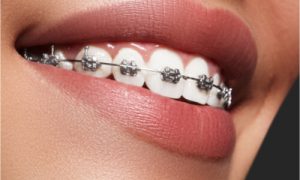Contents
Brackets on braces are the square metals that are attached to the front and side teeth. These parts of braces are directly bonded to the enamel that serves as the handles that hold the dental wire in place. The brackets are commonly made of stainless steel. Braces are used to correct teeth misalignment and overcrowding with the help of orthodontic treatments.
The Use of Dental Braces
To prevent dental issues, braces are offered to treat the following conditions:
- Crooked teeth
- Overcrowded teeth
- Overbite
- Underbite
- Teeth and jaw misalignment
Misaligned teeth can cause several problems to your oral health. It’s important to correct and treat this condition to fix the shape of the face, improve the appearance, biting, chewing, and speech skills.
Normally, braces are worn by children. Correcting the teeth structure in the early years is the most advisable time to get braces because the teeth are not yet fully recovered, hence giving the dentist enough time to correct the imperfections. However, adults can wear braces too. The only drawback is that it takes a longer time for an adult to complete the treatment because, at this point, your facial bones are not growing anymore. Adults often prefer clear aligners instead of braces, which are easier to remove for eating and drinking.
Different Parts Of Braces
 Apart from brackets, braces also include other important parts. Each of them plays a vital role in securing the whole brace in place.
Apart from brackets, braces also include other important parts. Each of them plays a vital role in securing the whole brace in place.
- Clear brackets. These have the same function as metal brackets. Some patients prefer this one because it makes the braces seem invisible.
- Bands. Bands are placed at the back teeth, specifically around the molars. A special dental cement is used to attach the bands onto the teeth.
- Archwire. If you notice, braces also include archwires that are attached to brackets. This is what connects all the brackets and bands together. The archwire is the one that’s responsible for actually correcting the misalignment.
- Rubber bands. Each side of the rubber band is attached to the upper bracket and lower bracket. This helps in gradually moving the teeth to achieve the desired alignment.
- O-rings. This is a material that holds the archwire to the brackets.
- Power and energy chain. These are used to help the teeth move along the archwire and to close gaps and spaces.
Risks Of Wearing Braces
Generally, braces are safe to wear. But just like other dental appliance, wearing one could put you at risk of the following:
- White stains in the teeth. This happens because the debris that is stuck on the braces is usually not thoroughly cleaned, resulting in loss of minerals in the enamel.
- Tooth decay and cavities. Without proper oral care, bacteria can start to build up as well.
- Failure of correction. If the patient fails to follow his dentists’ instructions, the purpose of the braces might get compromised. For instance, the patient does not strictly adhere to their appointment for adjustment, this could have a huge impact on the braces and the results.
Reducing Risks
To ensure that you achieve the best results of braces, you may opt to follow the following tips:
- avoid foods that promote plaque and tooth decay
- brush gently, clean your braces as well as your teeth regularly to remove debris and food particles
- rinse your mouth, toothbrushes can’t reach some parts of the gaps between the teeth, thoroughly clean your mouth by using a mouthwash
- floss your teeth and braces, always ensure that no debris is stuck in between them
- avoid foods that are sticky such as chewing gum and caramel, they could get entangled with the braces
- stay away from hard foods that can damage your braces
- do not forget to visit your dentist for adjustments and professional cleaning
- follow the instructions of your dentist on how to properly care for your braces
Go to Advanced Dental Care Dubbo for more information on braces care. Getting braces requires time, effort, and patience. The corrective procedure will mandate you to visit the dentist every month for adjustments and corrections. The results will also take some time so you have to be patient in waiting.

Leave a Reply